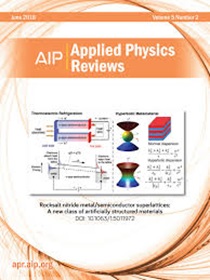核电池材料研究的当前趋势:利用金属钙钛矿卤化物和其他硫族化合物来提高紧凑性和效率
IF 11.6
1区 物理与天体物理
Q1 PHYSICS, APPLIED
引用次数: 0
摘要
核能作为一种有希望的、环保的解决方案出现,以对抗因过度使用化石燃料而导致的温室气体水平不断上升。利用这种能量的关键是核电池,这种装置通过捕获核衰变过程中释放的能量来发电,包括α或β粒子和γ辐射。核电池的吸引力在于其延长寿命、高能量密度的潜力,以及在恶劣环境下的适应性,在这些环境中,加油或更换电池可能是不可行的。在这篇综述中,我们将我们的重点缩小到利用非热转换器的核电池,如α-或β-伏特,以及那些使用闪烁中间体。将基于金属钙钛矿卤化物(MPHs)和硫族化物(MCs)的最先进的直接辐射探测器和闪烁体的最新进展与基于硅和III-V材料的传统探测器以及基于无机镧系元素晶体的闪烁体进行了比较。重点介绍了在MPH和MC探测器和闪烁体方面取得的显著成就,如纳米gy灵敏度、100光子/keV光产率和辐射硬度。此外,还讨论了探测器和闪烁体中由于辐射损伤而造成的能量转换效率、功率密度和保质期等限制。利用新型MPH和MC材料有可能推动核电池从目前的尺寸和功率限制到小型化,提高效率和增加功率密度。此外,探索核电池在无线传感器、低功耗电子、油井监测和医疗领域之外的小众应用,为未来的研究和发展提供了诱人的机会。本文章由计算机程序翻译,如有差异,请以英文原文为准。
Current trends in material research for nuclear batteries: Harnessing metal perovskite halides and other chalcogenides for greater compactness and efficiency
Nuclear energy emerges as a promising and environmentally friendly solution to counter the escalating levels of greenhouse gases resulting from excessive fossil fuel usage. Essential to harnessing this energy are nuclear batteries, devices designed to generate electric power by capturing the energy emitted during nuclear decay, including α or β particles and γ radiation. The allure of nuclear batteries lies in their potential for extended lifespan, high energy density, and adaptability in harsh environments where refueling or battery replacement may not be feasible. In this review, we narrow our focus to nuclear batteries utilizing non-thermal converters such as α- or β-voltaics, as well as those employing scintillation intermediates. Recent advancements in state-of-the-art direct radiation detectors and scintillators based on metal perovskite halides (MPHs) and chalcogenides (MCs) are compared to traditional detectors based on silicon and III-V materials, and scintillators based on inorganic lanthanide crystals. Notable achievements in MPH and MC detectors and scintillators, such as nano-Gy sensitivity, 100 photons/keV light yield, and radiation hardness, are highlighted. Additionally, limitations including energy conversion efficiency, power density, and shelf-life due to radiation damage in detectors and scintillators are discussed. Leveraging novel MPH and MC materials has the potential to propel nuclear batteries from their current size and power limitations to miniaturization, heightened efficiency, and increased power density. Furthermore, exploring niche applications for nuclear batteries beyond wireless sensors, low-power electronics, oil well monitoring, and medical fields presents enticing opportunities for future research and development.
求助全文
通过发布文献求助,成功后即可免费获取论文全文。
去求助
来源期刊

Applied physics reviews
PHYSICS, APPLIED-
CiteScore
22.50
自引率
2.00%
发文量
113
审稿时长
2 months
期刊介绍:
Applied Physics Reviews (APR) is a journal featuring articles on critical topics in experimental or theoretical research in applied physics and applications of physics to other scientific and engineering branches. The publication includes two main types of articles:
Original Research: These articles report on high-quality, novel research studies that are of significant interest to the applied physics community.
Reviews: Review articles in APR can either be authoritative and comprehensive assessments of established areas of applied physics or short, timely reviews of recent advances in established fields or emerging areas of applied physics.
 求助内容:
求助内容: 应助结果提醒方式:
应助结果提醒方式:


